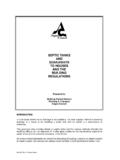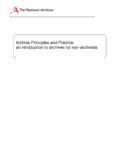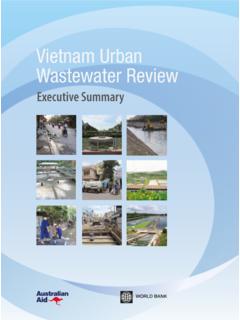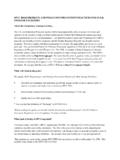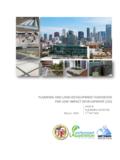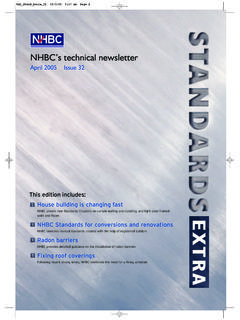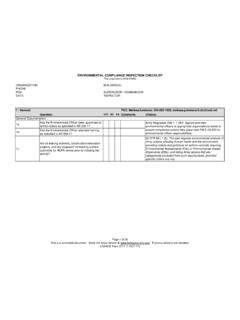Transcription of Water Use
1 Water Use In Your BusinessAdvice & tips for saving waterMaking your business watertightWater is a valuable resource, yet all too often we take it for your business is large or small it can only benefit from using Water the amount of Water your business uses will also reduce the amount of wastewater produced. This has the advantage of reducing both your Water and your sewerage or effluent charges. This leaflet provides tips on how your business could save Water and how you can get further are all using an increasing amount of Water . If this trend continues a point will be reached where Water companies will have to develop costly new sources of Water , which would undoubtedly, result in increased Water bills and have an unacceptable impact on our we all use Water carefully, it will help towards ensuring that our existing Water resources will be sufficient to meet demands even in the most extreme conditions for many years to come.
2 Reducing the amount of Water used may be easier than you think. Why not take a few minutes to complete our Water use checklist . It will help you to identify where your business could save Water and are a few suggestions to help awarenessIntroduce Water saving information during employee training to increase their awareness of the importance of using Water someone responsible for regularly reading meters. A marked increase in Water usage may indicate a waterIt may be cheaper to treat and recycle your process Water , than pay effluent and sewerage charges. Recycled process Water can be used for other purposes irrigation, cleaning, toilet flushing and processes to reduce Water consumption will also cut down the volume of wastewater requiring disposal.
3 As a result effluent and sewerage charges will you know how much Water your business uses?Reducing your consumption could save you average office-based businesses Water will more than likely be used in the following ways: Toilet flushing 43% Washing 27% Urinal flushing 20% Canteen 9% Cleaning 1%How much Water does each of your employees use each day?If you have a Water meter look at your previous bills and identify the volume of Water used (do not include estimated readings). You can then work out the Water use for each an example: Water used 920m3 a year (1m3 = 1000 litres) 60 Employees 260 working days Water used (litres) Water use for each employee = no. of staff x no.
4 Of working days920 x 1,00060 x 260 = 59 litres each employee each working dayOn average Water consumption, for office buildings, is 50 litres for eachemployee each working Water is used in manufacturing processes industry standards for consumption will need to be your consumption Find out about the layout of your plumbing system Find your stop taps Locate your internal stop tap or taps and ensure a number of people know where they are located. Check that you can turn them on and off. Find and read your meters Locate your site meters and sub meters. Make someone responsible for regularly reading meters either weekly or monthly. A marked increase in Water usage may indicate a for Water lossSelect a period when the building is not in use at night, during weekends or holidays.
5 At the start of the selected period take a reading from your Water meters, then after a number of hours take another reading. If the reading has increased this is an indication that Water is being used, which could be due to any of the following: Automatic Water using devices urinal flushing Process Water left running (manufacturing business) Leaking pipeworkLeak detectionRegularly check for leaks from overflows, pipes, radiators and storage tanks. All leaks should be repaired there is a leak or wastage of Water within the boundary of your business it is your responsibility to repair it. If you have difficulty locating where the burst is contact South Staffordshire Water - we may be able to regulationsWe have a statutory duty to protect the quality of the public Water supply.
6 Through our Water Regulations enforcement activities we endeavour to ensure that installers of new plumbing systems are aware of the regulations and their requirements. We undertake both proactive and reactive inspections to support this and provide advice and guidance to customers as hints on saving waterTapsA dripping tap can waste a lot of Water . Change the washer immediately. Spray taps or taps fitted with push-tops or infra red controls can reduce consumption by up to 50%. Urinal flushingAutomatic flushing of urinals can waste large quantities of Water . Using a control device can reduce consumption by up to 70% by ensuring that flushing stops, when the premises are not in use.
7 If you are refitting outdated equipment there are now waterless urinals flushingThe very latest low flush toilets use only 6 litres per flush. Older toilets use between and 13 litres per flush. If you have an older cistern try a Water saving device such as a Hippo or a Save-a-Flush bag. You could save between 1 litre and 3 litres per flush. Contact the Company or visit average, standard showers use 30 litres per shower, while power showers use 60 litres. Low volume shower heads can help reduce Water use by up to 50%.Do you run a restaurant or canteen?Large quantities of Water can be wasted in this area. Make sure that the staff are aware of your intention to save the time comes to replace equipment look out for low Water use models displaying the ECO quantities of Water can be wasted on grounds maintenance particularly during the summer months when rainfall is at its lowest.
8 Hose pipes and sprinklers can use 1000 litres per hour, therefore keep grass watering to a minimum. Fitting a trigger nozzle to a hosepipe ensures Water stops flowing as soon as it is released. Consider collecting rainwater in a tank or butt and using it for watering plants and shrubs. When landscaping try to select plants and shrubs that are tolerant of dry protectionMake sure all hot and cold Water pipes and tanks are insulated, especially in unheated areas of the premises. Insulating hot Water pipes can also reduce fuel Check1. Monitoring ConsumptionDoes a person have specific responsibility for monitoring the use of Water in your business?Do you know the location of your Water meter/s?
9 Do you read your Water meter/s regularly?Do you have sub meters which measure consumption in specific areas or by specific processes?Do you look for trends in your Water consumption? Do you check whether Water is being used in your buildings when they are empty?2. Leak DetectionDo you regularly look for leaks from overflows, pipes, joints and connections?3. WashroomsAre all your taps drip free? Do taps shut off automatically? Are all taps spray taps? Do urinals only flush when the premises are in use? If you have old urinal flushing controls are they functioning correctly? Do you have the latest low volume toilet cisterns (6 to ltrs)? Do you have displacement devices in older cisterns ( Hippo)?
10 Do you only have standard non power showers? Do you have low volume shower heads?4. CanteenAre your appliances new low Water use ECO models? YES NO N/AWater use checklist for businessesWhy not take a few minutes to complete our Water Use Checklist . It will help you to identify where your business could save Water and Check5. GroundsAre your hose pipes fitted with trigger nozzles? Do you keep grass watering to a minimum?Do you have drought tolerant plants and shrubs? Do you collect and use rainwater for watering plants and shrubs? 6. Outside cleaning and vehicle washingDo you recycle wash Water ? 7. Frost ProtectionAre hot and cold Water pipes and tanks adequately insulated against frost?
